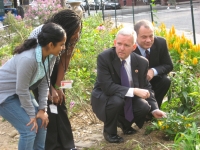Greening Queens Initiative at Queens Library
Queens Library, N.Y.
Innovation Synopsis
In 2010, Queens Library received a grant to conduct environmental education programs at the library. It began modestly and grew to include an extensive program of community gardens on or near library property, composting programs, conservation education for the community, especially for children.
Challenge/Opportunity
Queens Library received a grant to conduct programs of environmental interest. Being in a highly urban area, arable land is hard to find. People live far from their food production sources. Many live in apartments and do not have a full range of choices about how their power is generated or how their dwellings are insulated. Transportation options are limited. While people are interested in sustainability, they often don’t have much control over the variables and consequently are not well informed about environmental choices they can make successfully. It is particularly important for children to gain an environmentally-sound education since their living circumstances may well be very different from where they grew up. The challenge is to educate adults and children, in a library environment, and empower them to make sustainable choices where they are able to do so. The programs were timid at first and became more substantial as time went on.
Key Elements of Innovation
In 2010, Queens Library began a series of programs, primarily aimed at children, that encouraged environmental awareness. In the beginning, the programs were educational and fairly standard, about the water cycle and how food grows. The children planted seeds in paper cups. There were programs for adults about how much money they would save if they switched lightbulbs and insulated their attics. The programs were beneficial and informative. But the idea caught on, and people began to ask: “what else can we do?” Enviro Assistants were hired. They are young adults who have part-time jobs working on environmental projects with children after school. They are paid through the grant. They help engage them, while gaining resume-worthy work experience themselves. They program projects like weather experiments or hatching butterflies or raising worms. A few of the libraries have tiny side yards. With the donation of a few tools and plants, small community gardens were prepared and the children eeked out and were allowed to eat their own small amounts of beans and strawberries. They loved it. The library started a composting pick up project. Several times each week, the community is invited to drop off food scraps. Occasional e-waste pick-ups are scheduled. Shredding events and clothing swaps are held. Every event is more popular than the last. They are being held in more and more locations. People have been asking for them more often. The environmental activities have been so popular, the library re-applied for an extended grant and has expanded the program.
Achieved Outcomes
Environmental programs have been extremely popular and library customers ask for them constantly. Many travel out of their own neighborhoods to attend a composting event or e-waste recycling. It is changing the way people think about sustainability, even if you live in an urban area and cannot choose solar power or wind power. It will especially shape the way the children think. We learned that while risk management is an important and responsible function for a library, pushing the envelope a little is important, too. We cannot have people bringing their decomposing food into the library for composting, but we can ask them to drop off frozen scraps outside the library, and have a contractor there to receive them. There is always a way to work out an acceptable method to do what you want to do. And we learned that there is a growing interest in environmentalism, even in a big city. Or maybe because of it. We all long for a little more green.

